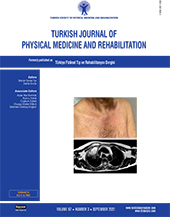Physiotherapy combined with therapeutic neuroscience education versus physiotherapy alone for patients with chronic low back pain: A pilot, randomized-controlled trial
2 Pamukkale University, School of Physical Therapy and Rehabilitation, Denizli, Turkey
3 Department of Physical Medicine and Rehabilitation, Univesity of Health Sciences, Antalya Training and Research Hospital, Antalya, Turkey DOI : 10.5606/tftrd.2021.5556 Objectives: The aim of this study was to investigate the effect of therapeutic neuroscience education (TNE) combined with physiotherapy on pain, kinesiophobia, endurance, and disability in chronic low back pain (CLBP) patients.
Patients and methods: Between November 2016 and December 2017, a total of 31 patients with CLBP (5 males, 26 females; mean age: 42.3±10.8 years; range, 20 to 58 years) were randomly allocated to receive physiotherapy combined with TNE (experimental group, EG, n=16) and physiotherapy alone (control group, CG, n=15). All participants received physiotherapy consisting of five sessions per week for a total of three weeks. In addition to physiotherapy, the EG received TNE sessions consisting of two sessions per week for a total of three weeks. The primary outcomes were pain intensity as assessed by Visual Analog Scale (VAS) and kinesiophobia by Tampa Scale for Kinesiophobia (TSK), while and the secondary outcomes were trunk muscle endurance as assessed by the partial curl-up test (trunk flexor endurance [TFE]) and modified Sorensen test (trunk extensor endurance [TEE]) and disability by Roland-Morris Disability Questionnaire (RMDQ).
Results: All patients completed the study. The median VAS, TSK, TFE, TEE, and RMDQ scores for the EG significantly improved after three weeks, while there was only significant improvement in the VAS, TSK, and RMDQ scores in the CG. The TSK decreased more in the EG than in the CG. The significant difference was evident in TSK and TFE in favor of the EG (p<0.05).
Conclusion: These results suggest that the combination of TNE with physiotherapy can improve kinesiophobia and trunk flexor muscle endurance of patients with CLBP in the short-term.
Keywords : Education; kinesiophobia; low back pain; modalities; pain; physical therapy

















